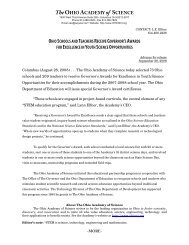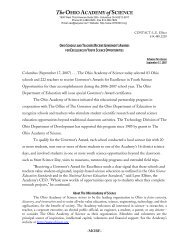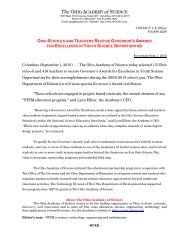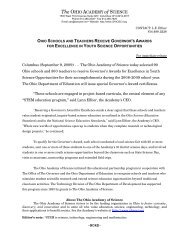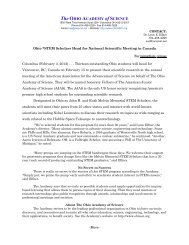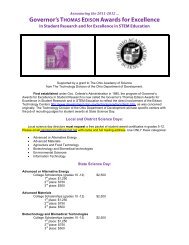The Ohio Journal of - The Ohio Academy of Science
The Ohio Journal of - The Ohio Academy of Science
The Ohio Journal of - The Ohio Academy of Science
Create successful ePaper yourself
Turn your PDF publications into a flip-book with our unique Google optimized e-Paper software.
A-42 <strong>The</strong> <strong>Ohio</strong> <strong>Journal</strong> <strong>of</strong> <strong>Science</strong><br />
Vol. 112(1)<br />
1nM solutions produced a limited growth with only 143%<br />
and 147% increases, respectively. <strong>The</strong>se results imply<br />
that diatoms can react to small amounts <strong>of</strong> iron in their<br />
environment and the optimal concentration to remove the<br />
most carbon dioxide from the atmosphere was around 5<br />
nM. <strong>The</strong>se findings suggest that iron fertilization may be<br />
adopted as a carbon sequestration strategy.<br />
Poster Board No. 026 THE EFFECTIVENESS OF THE SOLAR<br />
DISINFECTION METHOD (SODIS) IN TREATING CONTAMINATED<br />
WATER. Osama Alkhalili, osamaalkhalili8@yahoo.com, 4691<br />
Fairway Lane, Sylvania <strong>Ohio</strong> 43560 (Maumee Valley Country<br />
Day School).<br />
<strong>The</strong> lack <strong>of</strong> access to safe drinking water in undeveloped<br />
nations demands finding affordable water-disinfection<br />
methods. This project investigates the effectiveness<br />
<strong>of</strong> the solar disinfection method (SODIS) in treating<br />
contaminated water. It is hypothesized that exposing<br />
contaminated water to sunlight for a specific time will<br />
be effective in disinfecting the contaminated water. All<br />
tools were sterilized by boiling prior to collecting a water<br />
sample from Lake Olander in Sylvania, <strong>Ohio</strong>. Two clean<br />
16-oz PET plastic bottles were filled with the lake water,<br />
placed onto a dark, metal sheet beneath a lamp with a<br />
Daylight Blue Reptile bulb and exposed to UV-A light at<br />
350 nm for 12 and 24 hours, respectively. A third PET<br />
bottle was filled with filtered lake water using a Whitman<br />
Filter Paper and exposed to UV-A light for 24 hours. One<br />
cup <strong>of</strong> the lake water was boiled for 15 minutes. Samples<br />
were cultured on tryptic soy agar plates. Bacterial colonies<br />
in each plate were counted after 24, 48, 72, and 96 hours.<br />
<strong>The</strong> entire experiment was repeated two additional times.<br />
In the untreated sample, the average numbers <strong>of</strong> bacterial<br />
colonies were 95, 170, 320, and 500 at 24, 48, 72, and 96<br />
hours, respectively. Boiled sample showed no bacterial<br />
growth over the 96-hour period. <strong>The</strong> 12-hour SODIS sample<br />
resulted in an average bacterial growth <strong>of</strong> 30, 45, 75 and<br />
130 colonies at 24, 36, 48 and 96 hours, respectively. <strong>The</strong><br />
unfiltered 24-hour SODIS sample resulted in an average<br />
bacterial growth <strong>of</strong> 5, 8, 12, and 22 colonies at 24, 48,<br />
72, and 96 hours, respectively, while the filtered 24-hour<br />
sample had 2, 4,7, and 12 colonies at 24, 48, 72, and 96<br />
hours, respectively. Results showed that boiling is the most<br />
effective method for disinfecting contaminated water. <strong>The</strong><br />
SODIS method could be fairly effective, if optimal exposure<br />
time is used. <strong>The</strong> turbidity <strong>of</strong> the water may reduce the<br />
efficiency <strong>of</strong> the SODIS method, which can be corrected<br />
easily by water filtration. <strong>The</strong>se findings suggest that the<br />
SODIS can be adopted as a water-disinfection method<br />
in undeveloped nations that do not have the means and<br />
infrastructures to clean and disinfect their drinking water.<br />
Poster Board No. 027 THE EFFECTS OF GREEN MATERIALS<br />
UTILIzED AS ABSORBENTS IN OIL SPILL CLEAN UP. Hannah A.<br />
Barlow, mbarlow25@yahoo.com, 7245 zwickle Rd., Logan OH<br />
43138. (Logan-Hocking Middle School)<br />
This project began out <strong>of</strong> concern over the 2010 Gulf<br />
<strong>of</strong> Mexico oil spill cleanup efforts, to determine which<br />
materials would best absorb oil. It was hypothesized that<br />
“green” materials could be used to effectively absorb oil.<br />
Materials used were 1.5 cattail seed heads, 2 corn cobs, 4<br />
pine cones (Spruce), and 1 cup (227kg) Lake Huron zebra<br />
mussel shells. <strong>The</strong>se “green” materials were crushed to<br />
measure one-half cup (113kg), and then placed into each<br />
<strong>of</strong> the one cup (227kg) capacity funnels with 6 ½ inch<br />
(16.5cm) necks. Next, one-half cup (118ml) <strong>of</strong> used motor<br />
oil was poured into each <strong>of</strong> the funnels to drain into one<br />
cup (250ml) glass beakers. Cattail seed heads absorbed 2.5<br />
oz. (75ml) <strong>of</strong> oil or approximately 60%. Corn cobs absorbed<br />
2.02 oz. (60 ml) <strong>of</strong> oil or approximately 50%. Pine cones<br />
absorbed .51 oz. (15ml) or approximately 13%. Zebra<br />
mussel shells absorbed .34oz. (10ml) or approximately<br />
less than 1%. <strong>The</strong>se results indicate that it would take<br />
approximately 3 cattails to absorb one cup (236ml) <strong>of</strong> oil.<br />
Based on 16 cups (3784ml) per 1 gallon, it would take 48<br />
cattails to absorb one gallon <strong>of</strong> oil, and therefore 2,016<br />
cattails per barrel <strong>of</strong> oil based on a 42 gallon barrel. Since<br />
60,000 barrels <strong>of</strong> oil were leaked daily during the 2010 Gulf<br />
oil spill, it would take approximately 120,960,000 cattails<br />
to absorb one days worth <strong>of</strong> oil from the Gulf oil spill, or<br />
11,007,360,000 cattails to absorb the 91 days worth <strong>of</strong> oil<br />
spilled into the Gulf <strong>of</strong> Mexico. This research demonstrates<br />
that green technology could be considered and used as an<br />
environmentally sound solution for future oil spills.<br />
Schar Room 266<br />
Poster Board No. 033 AQUATIC OIL SPILL CLEAN-UP. Abigail<br />
L Myers, myersa13@embarqmail.com, 4251 N County Line<br />
Rd, Sunbury, OH 43074 (Big Walnut Middle School)<br />
Oil produced <strong>of</strong>fshore to meet energy needs is transported<br />
through aquatic environments. In <strong>of</strong>fshore drilling and<br />
production (e.g., BP Deepwater Horizon) and oil transport<br />
(e.g., Exxon Valdez), accidental spills occur. <strong>The</strong>refore,<br />
cleaning up spills is necessary – one method is to use<br />
sorbents. For a sorbent to be successful in an aquatic<br />
environment, it must have a high level <strong>of</strong> oleophilicity and<br />
be hydrophobic. Absorption and adsorption are processes<br />
that can remove oil from water. Through absorption, oil fills<br />
in cavities in the sorbent and through adsorption oil sticks<br />
to the material surface. This experiment investigated how<br />
well synthetic (polypropylene, polyurethane, and polyester)<br />
and organic (cotton, straw, and sawdust) sorbents remove<br />
oil from water by absorption and/or adsorption. Initial<br />
research led to the hypothesis: synthetic sorbents would<br />
remove more oil than natural organic sorbents, with<br />
polypropylene being the best. Each sorbent (1.5g) was<br />
placed into a beaker containing an oil slick (20 ml) floating<br />
on the water surface (150 ml), timed (5 min), and removed.<br />
<strong>The</strong> masses <strong>of</strong> used sorbent and fluids were determined,<br />
and volumes <strong>of</strong> remaining fluids were measured. <strong>The</strong><br />
synthetic sorbents demonstrated greater effectiveness than<br />
natural organic sorbents, with a mean weight ratio (mass<br />
<strong>of</strong> oil removed to mass <strong>of</strong> sorbent used) <strong>of</strong> 9.5, compared<br />
to 7.9 for organic sorbents. Based on this experiment,<br />
polyester removed the most oil, with a weight ratio <strong>of</strong> 13.5,<br />
followed by cotton (12.2), polypropylene (9.4), sawdust<br />
(6.6), polyurethane (5.5) and straw (4.9). Additional work<br />
could include revised methods to simulate wave action.<br />
Poster Board No. 034 LEAD CONTENT OF SCHOOL DRINKING<br />
WATER. Halle A. Miller, millerbdhc@aol.com, 13684 Janell<br />
Drive, Columbia Station OH 44028 (Columbia High School)<br />
<strong>The</strong> goal <strong>of</strong> this project was to discover how the lead content<br />
<strong>of</strong> drinking water varied between school buildings <strong>of</strong><br />
different ages. <strong>The</strong> objective was to determine if there was<br />
a direct correlation between school age and the lead content<br />
<strong>of</strong> its drinking water. <strong>The</strong> hypothesis was that if a school is<br />
older, the lead content <strong>of</strong> the drinking water will be greater<br />
because <strong>of</strong> different piping and soldering methods used in<br />
the past. Three water samples were collected from each <strong>of</strong><br />
ten different public high schools from a restroom sink. Each<br />
sample was collected from a faucet running cold water and<br />
the test tubes were sealed with Parafilm. A stopwatch was<br />
used to time thirty seconds between samples. <strong>The</strong> samples<br />
were tested at the Avon Lake Water Filtration Plant, with<br />
help from a qualified scientist, using the graphite furnace<br />
<strong>of</strong> an Atomic-Absorption Spectrometer. Standard samples<br />
were analyzed for calibration and then conducted on Test<br />
Group #1. A blank sample was run to recalibrate the<br />
machine and the process was repeated for Test Group #2<br />
and then Test Group #3. <strong>The</strong> standard deviation results in<br />
parts per billion (site one 2.68ppb, site two 0.40ppb, site<br />
three 0.35ppb, site four 0.91ppb, site five 9.45ppb, site six<br />
0.38 ppb, site seven 9.45ppb, site eight 0.68ppb, site nine<br />
0.17ppb, site ten 0.69ppb), were under the EPA specified<br />
15ppb. However, some <strong>of</strong> the raw samples reached levels<br />
<strong>of</strong> 20.0ppb and 25.3ppb. <strong>The</strong> results were found to support<br />
the hypothesis, on average. <strong>The</strong> schools built before 1967<br />
had greater lead contents, on average, and the schools<br />
built during or after 1967 had little to no lead detected in





